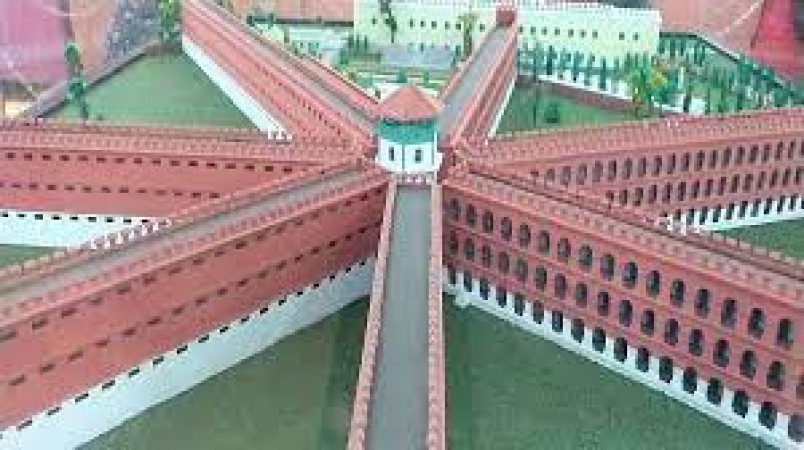Cellular Jail Travel Guide
Cellular Jail, located in the Andaman and Nicobar Islands of India, holds great historical significance as a colonial prison used by the British to exile political prisoners. Built in the late 19th century, it stands as a symbol of India's struggle for independence. The jail's isolated location in the middle of the sea, its seven wings representing seven isolated cells, and the harsh treatment of prisoners make it a stark reminder of the country's past.Top Attractions in Cellular Jail
1. Sound and Light Show depicting the history of the jail 2. Netaji Subhash Chandra Bose Island visit 3. Ross Island for its historical ruins 4. Radhanagar Beach for pristine white sands 5. Scuba diving and snorkeling in the clear watersCellular Jail is Famous for
Its notoriety as a prison where freedom fighters were incarcerated and tortured during the British rule.Top Attractions in Cellular Jail
- Sound and Light Show depicting the history of the jail - Netaji Subhash Chandra Bose Island visit - Ross Island for its historical ruins - Radhanagar Beach for pristine white sands - Scuba diving and snorkeling in the clear watersWhat's Great about Travelling to Cellular Jail?
- History buffs will appreciate the rich heritage - Beach lovers can enjoy the serene surroundings - Adventure seekers can indulge in water sportsWhat's Not So Great about Travelling to Cellular Jail?
- Not suitable for those seeking a bustling city experience - Limited dining and entertainment options - Remote location may not appeal to all travelersTravel Tips for Cellular Jail
- Obtain necessary permits for visiting restricted areas - Plan accommodation in advance due to limited options - Stay hydrated and carry essentials during outdoor activitiesImportant Cellular Jail trip information
- Ideal Duration: A minimum of 3-4 days is recommended to explore the main attractions.
- Best Time to Visit: November to February offers pleasant weather for sightseeing.
- Nearby Airports and Railway Stations: Veer Savarkar International Airport and Port Blair Railway Station serve as the main entry points.
FAQ's on Cellular Jail
Q1: What is the best time to visit Cellular Jail?
The best time to visit Cellular Jail is during the winter months from November to February when the weather is pleasant and ideal for exploring. This time also coincides with various cultural events and festivals, adding to the vibrant atmosphere of the destination. Tourist seasons are less crowded during these months, allowing for a more enjoyable experience.
Q2: Do I need a visa to travel to Cellular Jail?
As Cellular Jail is a part of India, international tourists need to obtain an Indian visa to visit the destination. Different types of visas are available depending on the purpose of the visit. Travelers should check the specific visa requirements based on their nationality and make necessary arrangements well in advance.
Q3: What are the must-visit attractions in Cellular Jail?
Some of the must-visit attractions in Cellular Jail include the historic Cellular Jail itself, known for its significance in India's struggle for independence. The Sound and Light Show at the jail is a captivating experience. Additionally, exploring the picturesque Corbyn's Cove Beach, visiting the Samudrika Marine Museum, and taking a ferry to Ross Island are highly recommended for travelers.
Q4: Is Cellular Jail a safe place to travel?
Cellular Jail is generally a safe place to travel for tourists. However, like any destination, travelers should exercise caution, especially in crowded areas and late at night. It is advisable to avoid isolated areas and be mindful of personal belongings. Following basic safety precautions and being aware of surroundings can help ensure a safe and enjoyable trip.
Q5: What is the local currency in Cellular Jail and can I use credit cards?
The local currency in Cellular Jail is the Indian Rupee (INR). ATMs are available in the main town area for convenient access to cash. While credit cards are accepted at some hotels, restaurants, and larger stores, it is recommended to carry sufficient cash for smaller establishments and local markets.
Q6: What is the local cuisine like in Cellular Jail?
The local cuisine in Cellular Jail offers a mix of traditional Indian flavors with a focus on seafood due to its coastal location. Popular dishes include seafood curries, coconut-based preparations, and local delicacies like fish fry and crab masala. Vegetarian options like dosas, idlis, and biryanis are also widely available. Travelers with dietary preferences or restrictions can easily find options to suit their needs in the local restaurants.
Q7: What transportation options are available in Cellular Jail?
Transportation options in Cellular Jail include public buses, auto-rickshaws, and taxis for getting around the island. Renting a scooter or a car is also a popular choice for more flexibility in exploring the destination. Additionally, guided tours and boat rides are available for visiting nearby islands and attractions. Travelers can choose the mode of transportation based on their preferences and itinerary.
Q8: Are there any cultural norms or etiquette I should be aware of when visiting Cellular Jail?
When visiting Cellular Jail, it is important to respect local customs and traditions. Modest attire is recommended when visiting religious sites or interacting with locals. Removing shoes before entering temples or homes is considered polite. Additionally, asking for permission before taking photographs of people or religious sites is courteous. Greeting others with a smile and a "Namaste" is a common gesture of respect. Being mindful of cultural norms and showing appreciation for the local heritage can enhance the travel experience in Cellular Jail.
Q9: I am a travel agent. How can I buy travel leads of Cellular Jail?
Register yourself as a travel agent at agents.tripclap.com and then you can buy travel leads to Cellular Jail once your account is approved. For more details contact our support team at +91-8069186564 or support@tripclap.com

